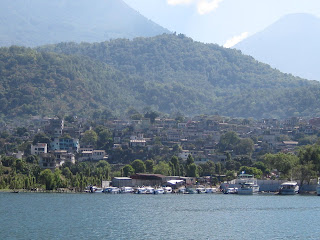 On Friday, January 9th, I wasn’t needed at the university, so I decided to take a tour of three villages on Lake Atitlán to get to know my environment better. There are thirteen villages around Lake Atitlán. Every village attests to the strength and diversity of Maya culture. The three villages on this particular boat tour were San Pedro La Laguna, Santiago Atitlán, and San Antonio Palopo. Santiago Atitlán and San Antonio Palopo are still intensely traditional. The indigenous inhabitants still wear beautiful trajes unique to their village.
On Friday, January 9th, I wasn’t needed at the university, so I decided to take a tour of three villages on Lake Atitlán to get to know my environment better. There are thirteen villages around Lake Atitlán. Every village attests to the strength and diversity of Maya culture. The three villages on this particular boat tour were San Pedro La Laguna, Santiago Atitlán, and San Antonio Palopo. Santiago Atitlán and San Antonio Palopo are still intensely traditional. The indigenous inhabitants still wear beautiful trajes unique to their village.San Pedro La Laguna, on the other hand, much like Panajachel, has been infiltrated by western bohemians. However, the indigenous people and the “stoners” appear to tolerate one another. One big attraction for westerners to flock to San Pedro La Laguna is the famous nearby volcano San Pedro which can be climbed by ambitious hikers in a day. The boat tour to the three villages costs only 90 Quetzales (around 11 dollars) and it lasts seven hours. It was a beautiful day, very sunny and in the low 80’s, typical weather for January. Here are some pictures taken in San Pedro La Laguna, our first stop.
San Pedro La Laguna: 98% of its 10,000 inhabitants are Tz'utujil
Girl selling fresh mango. The mango is crunchy
with a sprinkle of lime, salt, and hot spice.
Precious cargo- picops are a common means of public transportation
One of the many artesian shops in San Pedro
Cafe advertising Guatemalan coffee-producing areas
Una pedrana
Street hawker on tour boat
Santiago Atitlán is the largest of the communities around the lake with a population of over 32,000, 95% of which are indigenous Tz’utujils. Traditionally, it is fishing and farming town; it is also known for the manufacture of cayucos, wooden canoes. Directly from the dock, the main street leads visitors up to the main square where there is a vibrant, very lively market, both indoor and outdoor. Street hawkers swoop down on the gringos as they stroll by the weaving shops and art galleries.
Santiago Atitlán is also known for its brave stance against military forces in the 1980’s and later on in the 1990’s. Because of their refusal to adhere to military rule in the 1980’s, the government accused inhabitants of cooperating with ORPA guerrillas and began to terrorize them into submission. Consequently, 300 hundred villagers were murdered over an 11-year period and countless others arrested and tortured. There were other incidents in which the people of Santiago Atitlán courageously fought against violent, oppressive acts from police and military. In one incident, they refused to sell food to new police recruits or let them use public toilets for one month.
Here are some glimpes of Santiago Atitlán:
Santiago Atitlán
On Main Street in Santiago Atitlán
Friday Market
 Man passing by
Man passing by Una Atiteca
Una Atiteca The famous cayucos of Santiago Atitlán
The famous cayucos of Santiago AtitlánLake Atitlán or Lago de Atitlán has been praised for centuries by travelers as a breathtaking natural wonder. Even Aldous Huxley called Atitlán the most beautiful lake in the world. According to his Beyond the Mexique Bay (1934), Huxley writes “…Atitlan is [Lake] Como [in Northern Italy] with the additional embellishments of several immense volcanoes. It is really too much a good thing.” The lake is about 12 miles long and 7 ½ miles wide but from an aerial view, it has an irregular shape due to the many bays and inlets. During the morning, the lake is generally calm but the xocomil (the north wind) picks up in the afternoon, making boat rides choppy. According to Mayan legend, the presence of the north wind indicates that the lake has discarded the body and claimed the soul of someone who has drowned. The health of the lake is constantly tested by recent population expansion (over 100,000 people live around the lake) as well as the sequential destruction of natural environment (such as the sea grass that acts as a natural cleanser). Here are some attempts to capture this lake's magnificence.
View of the lake from Santiago Atitlán
 San Pedro, one of the three dormant volcanos
San Pedro, one of the three dormant volcanos
Toliman and Atitlán Volcanoes


Water reed called tul which detoxifies lake
It is the end of the boat tour and a perfect day.

















No hay comentarios:
Publicar un comentario